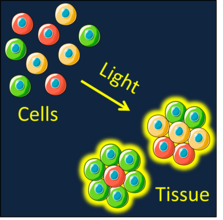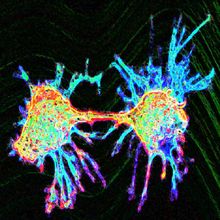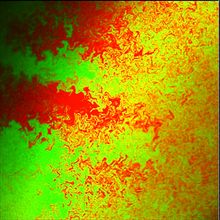
Light controlled minimal cellular systems
During evolution the transition from unicellular to multicellular life led to many emergent properties and an explosion in the complexity of life forms. To achieve equivalent complexity and emergence in bottom-up assembled minimal synthetic cells, it is important to control the self-organization of minimal synthetic cells, in which various life processes take place. This requires the precise spatiotemporal control of interactions between different minimal synthetic cells as well as other interphases. With the help of photoswitchable interactions, we seek to control the adhesive interactions of synthetic minimal cells and their self-assembly and self-sorting by using visible light. The unique properties of these interactions, will allow us to regulate communication between synthetic cells, to trigger dynamic events such as uptake, migration and fusion, as well as to form consortia of synthetic cells, where different members contribute diverse functionality.

Photoswitchable cell-cell interactions for bottom-up tissue engineering
The bottom-up assembly of tissue from cellular building blocks constitutes a promising, yet highly challenging approach to engineer complex tissues. The challenge lies in controlling cell-cell interactions, which determine how cells organize with respect to each other, how they work together and consequently whether such a multicellular architecture will be functional. We aim to regulate cell-cell interactions with visible light, which will provide sustainable, non-invasive, dynamic and reversible control over cell-cell interactions with unprecedented spatial and temporal resolution. Using these photoswitchable cell-cell interactions, we want to assemble cells into multicellular architectures with predictable, dynamic and programmable organization. The photoswitchable cell-cell interactions are also a great way to answer key questions in biological processes where cell-cell interactions play a pivotal role in such as embryogenesis, cancer progression and tissue development.

Light-controlled cell-material interactions
Cell-material adhesions are fundamental in cell biology. Not only the chemical identity of the material, but also the spatial and temporal presentation of the adhesion molecules determine how different cell types interact with a material and activate signaling. Hence, the design of cell-instructive materials for studying cell biology and applications in tissue engineering, medical implants and cell-based screening all require independent spatiotemporal control of cell-material interactions, not just for one but for multiple cell types. By using photoswitchable proteins that respond to different colors of light, we want to photochemically control the cell-material interactions for multiple cell types. Manipulating cell-material interactions photochemically will give us control over cell adhesion with high spatial and temporal resolution, making it possible to study and manipulate intercellular processes such as collective cell migration and differentiation, and intracellular processes such as focal adhesion dynamics and signaling. Such a platform will offer us valuable insights into interactions between cells and synthetic surfaces and can be applied to the development of new bio-instructive materials.

Engineering designer biofilms with light
Biofilms are not only a leading cause of chronic infections and biofouling, but seen positively they also have tremendous potential in biotechnology for biocatalysis and waste treatment. Biofilms are spatially structured communities of microbes, which allow bacteria to work together and perform biochemical transformations, which planktonic bacteria cannot catalyze by themselves. Controlling bacterial adhesion to surfaces and to each other represents a promising opportunity to influence the microstructure of biofilms, to understand social interactions between bacteria and to design biofilms. Our goal is to engineer bacterial biofilms by controlling the adhesion of bacteria to substrates and to each other with light in a spatiotemporally controlled way. Based on these dynamically programmable interactions, we can rationally design bacterial biofilms with specific and desired properties.

